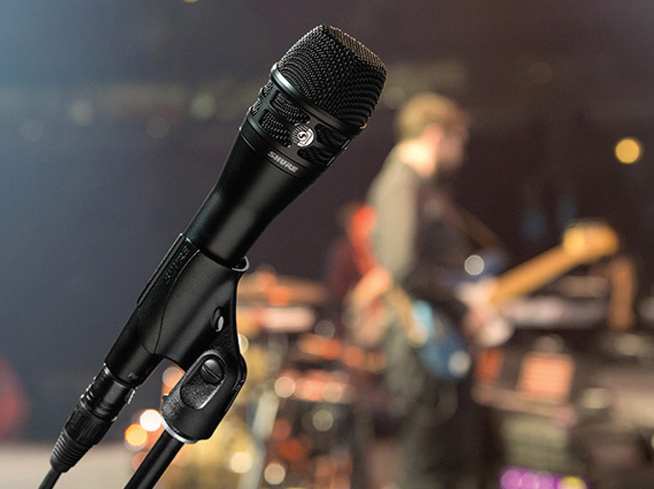Condenser microphones need phantom power to operate their internal circuitry. The power is supplied to the mic through its 2-conductor shielded cable and can be provided either from a stand-alone device or from a mixing console (at each mic connector).
The microphone receives power from, and sends audio to, the mixer along the same cable conductors. It’s called “phantom” because the power does not need a separate cable; it’s “hiding” in the signal conductors.
According to DIN standard 45596, phantom powering is a positive voltage (12-48 volts DC) on XLR pins 2 and 3 with respect to pin 1. The cable shield is the supply return. There is no voltage between pins 2 and 3. Pin 1 is ground; pin 2 is audio in-polarity, and pin 3 is audio opposite-polarity. Also, pin 1 has 0 volts; pin 2 has a positive voltage, and pin 3 has the same positive voltage as pin 2.
The phantom on/off switch in many consoles is labeled “P48” to signify “phantom power 48 volts. Figure 1, top, shows a microphone plugged into a stand-alone phantom power supply. Inside the phantom supply (Figure 1, middle) are two equal resistors R. They supply equal voltage to pins 2 and 3 with respect to the pin 1 ground. Inside the mic, phantom power is tapped off two equal resistors (or a center-tapped transformer).
Figure 1, bottom, shows how the phantom current travels through the mic cable from right to left:
— The current leaves the DC power-supply positive terminal and goes through two equal resistors
— The current travels along the mic cable to the mic.
— The current is recovered inside the mic and goes through the mic circuitry.
— The current returns to the DC power-supply negative terminal via the cable shield.

Some microphones or mic capsules work on DC bias rather than phantom power. A separate wire supplies B+ to the mic capsule. You’ll see this arrangement in lavalier mics or choir mics between the mic capsule and its XLR connector.
The mic capsule itself runs off DC bias, while the XLR connector houses a circuit that runs off phantom power. That circuit converts phantom power to DC bias for the mic capsule and balances the signal.
Why Condenser Mics Need Power
Let’s explain why condenser mics need power in order to operate. In a condenser microphone transducer (Figure 2), a conductive diaphragm and an adjacent metallic disk (backplate) are charged with static electricity to form two plates of a capacitor.

When sound waves strike the diaphragm, they vary the spacing between the plates. This varies the capacitance and generates an electrical signal similar to the incoming sound wave. The diaphragm and backplate can be charged in two ways:
— By an externally applied voltage (from phantom power). This arrangement is called “external bias” or “true condenser.”
— By a permanently charged electret material in the diaphragm or on the backplate. This is called “internal bias” or “electret condenser.”
The output of the condenser mic capsule is extremely high impedance so it is very hum-sensitive. To bring that impedance down to a usable value, an impedance-converter circuit is connected to the capsule output.
This circuit is necessary whether the capsule is electret or non-electret. The converter needs a DC voltage to power it, and this voltage is supplied by the phantom power supply. Sometimes other transistors are added to give the mic a balanced output, and these components work off phantom power too.
In contrast, a dynamic microphone needs no power because it has no active electronics. It generates its own electricity like a loudspeaker in reverse. In a moving-coil dynamic microphone (Figure 3), a coil of wire is attached to a diaphragm.

This voice coil is suspended in a magnetic field. When sound waves vibrate the diaphragm and its attached coil, the coil vibrates in the magnetic field and generates an electrical signal similar to the incoming sound wave. The voice-coil leads are soldered to XLR pins 2 and 3 inside the microphone.
In a ribbon microphone (Figure 4), the diaphragm is a thin metal foil or ribbon. Sound waves vibrate the ribbon in a magnetic field and generate corresponding electrical signals. The ribbon leads are soldered to XLR pins 2 and 3 inside the microphone.

You can plug a dynamic or ribbon microphone into a phantom supply without damaging the mic. That’s because the voice-coil or ribbon leads are not connected to pin 1, so no current from the phantom supply can flow through them. However, if there’s any imbalance in the phantom voltage applied to pins 2 and 3, a current will flow through the microphone voice coil or ribbon (which is connected to pins 2 and 3).
Or, if one terminal of the coil or ribbon is accidentally shorted to the grounded mic housing, a current will flow through the coil or ribbon. For this reason, it’s best to switch off phantom power for dynamic and ribbon mics.
Using A Stand-Alone Supply
You can buy a phantom power supply from your microphone dealer or online. Some supplies are AC powered, some are battery powered, and some are both. Some can power a single mic, others can power several at once.
In any case, you plug the supply in series with the mic cable. The supply has XLR-type input and output connectors, one pair per channel.
Connect a mic cable between your microphone and the supply’s input connector. Plug another mic cable between the supply’s output connector and your mixer mic input. If you need to convert a low-Z condenser mic to high-Z unbalanced using a transformer/adapter, run the mic through a stand-alone phantom supply before converting it to high-Z unbalanced.
Cautions For Use
Don’t plug a mic into an input with phantom already switched on or you’ll hear a loud pop. If you have no choice (as during a live concert), mute the mic channel when you plug the mic in.
Make sure your phantom voltage is adequate for your microphones. Some mics start to distort or lose level if the phantom voltage drops significantly below 48 volts.
To measure the phantom voltage at your mixer’s mic input, get a DC voltmeter and measure between XLR pins 1 and 2. Do the same between pins 1 and 3.
Be aware of phantom-voltage sag. Microphones draw current through the phantom-supply’s resistors, and that current causes a voltage drop E = IR across each resistor. The higher the current drain of a microphone, the more it drops the phantom voltage at the mic connector. Current drain is usually specified in the mic’s data sheet.
Power supplies are rated in the total number of milliamps they can supply. Make sure that the total current drain of all the mics plugged into the supply doesn’t exceed the supply’s current rating.
Avoid having phantom in a patch bay because someone is likely to patch in and cause a pop. If you must patch into a jack with phantom on it, mute the input module that the mic is connected to, or turn down its fader. Mic-level patches should be avoided anyway.
Some phantom supplies cause a hum when you plug in a connector that ties the shell to ground. This also helps to prevent ground loops.
Since the cable shield carries the DC return, be sure the shield and its solder connections are secure. Otherwise, you can expect crackling noises, especially when the cable is moved.
Some microphones work on either internal batteries or external phantom power. In most designs, connecting the mic to phantom automatically removes the battery from the circuit. Otherwise, the battery would severely load down the phantom supply. If this appears to be happening, remove the battery.
If a condenser microphone doesn’t work due to low phantom-supply voltage after the mic is plugged in, try these suggestions:
— Supply phantom from a better-regulated console.
— Use a mic with less current drain or with lower phantom-voltage requirements.
— Add a voltage regulator to the supply voltage.




















